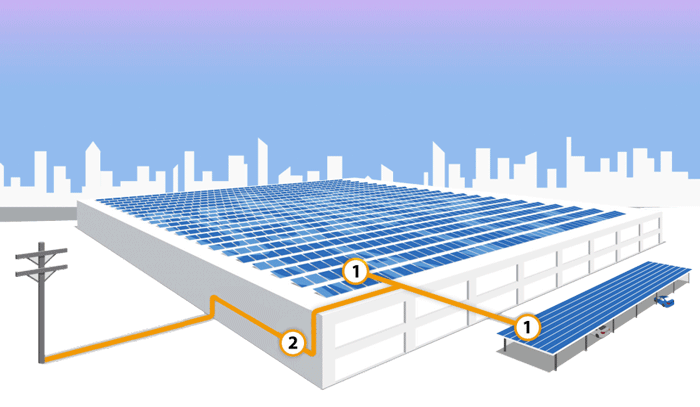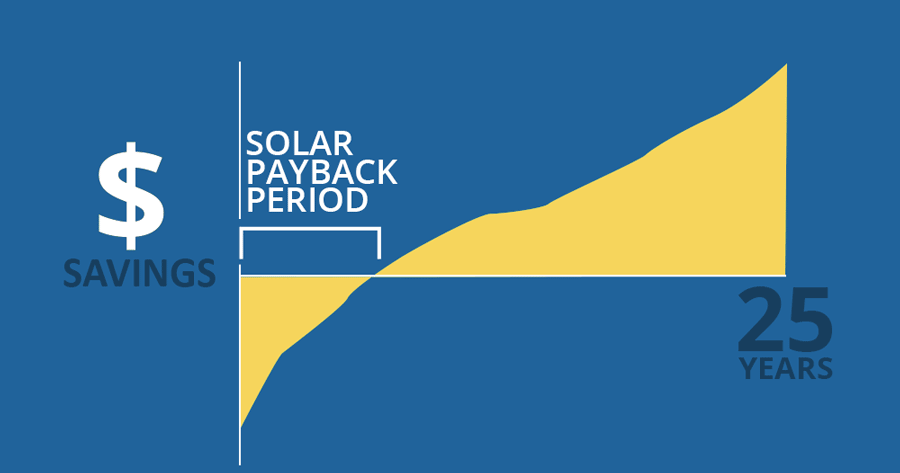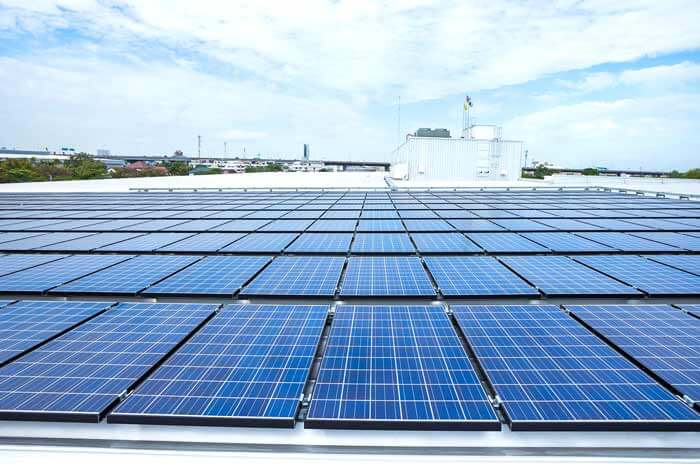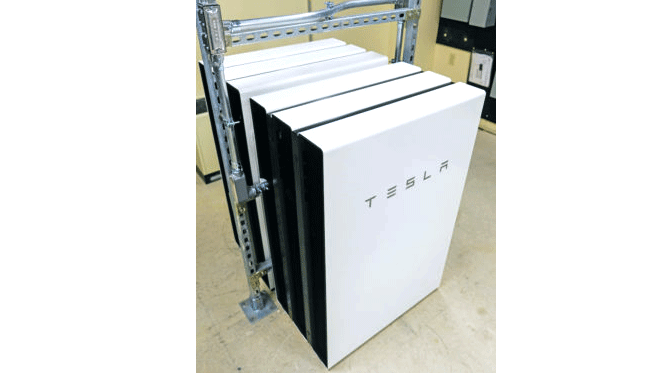Home Commercial Solar 50kW Commercial Solar System Cost
50kW Commercial Solar System Cost
The 50kW solar system is quite popular for commercial applications, as it fulfils a large chunk of the power needs of small to medium enterprises.
On average, a 50kW solar system will cost around $46,605, including government rebates and other incentives. The true range depends on your location and the brand of solar panels and inverter you go with.
The installation cost is usually included in this price range, as a certified installer can only do it.
Table of Contents
ToggleGovernment Rebate for 50kW solar system
| State | System Size | Zone | Zone rating | Rebate |
|---|---|---|---|---|
| New South Wales | 50kW | 3 | 1.382 | $18,982 |
| Queensland | 50kW | 1 | 1.622 | $22,283 |
| South Australia | 50kW | 3 | 1.382 | $18,982 |
| Victoria | 50kW | 4 | 1.185 | $16,270 |
| Western Australia | 50kW | 3 | 1.382 | $18,982 |
| ACT | 50kW | 3 | 1.382 | $18,982 |
| Northern Territory | 50kW | 1 – 2 | 1.536 | $21,104 |
| Tasmania | 50kW | 4 | 1.185 | $16,270 |
The government’s solar rebate initiative has been crucial in helping Australian businesses afford solar systems. The program, under the Small-Scale Renewable Energy Scheme, provides incentives for solar systems under 100kW.
The rebates come in the form of Small-scale technology certificates, STCs, which are tradable certificates you can exchange for discounts on your solar systems.
The rebate amount will also vary depending on your location by it ranging between $16,270 and $22,783.
States with higher sunlight intensities got a higher postal rating than those with lower intensities. As such, the rebate amount you receive for your 50kW solar system in Canberra won’t be the same as you’ll receive in Melbourne.
Here’s how you can calculate the number of STCs you can receive:
Formula: kW solar panels x 10-year deeming period x Zone rating X Spot STC price. (The deeming period is the time left to 2030 – when the program will be completely phased out, and the spot check price used is $39.30 (average of last month)).
Note: Different states also offer state-level rebate programs that are independent of the federal government rebate. Residents in Victoria, Western Australia, South Australia, NSW, and Tasmania can complement the federal rebates to the state rebates to significantly reduce the cost of solar systems.
The state governments in Tasmania and Queensland are also offering solar grants which can drastically cut down solar costs.
What’s the Feed-in tariff for a 50kW solar system
Once you have your 50kW solar system installed, you can quickly reduce its payback period through the feed-in tariff program.
Under this program, select energy companies around the country pay solar owners to sell back the excess energy they produce from your solar system. The program favors residential and SME solar installations.
For your 50kW solar system, you’ll first have to confirm if your energy company allows that size for the program. Keep in mind; most companies have an upper limit for the size of the solar system they can accommodate for the program.
In terms of the feed-in rate you’ll receive for your power, different companies will offer you different rates. These figures will vary depending on your state.
To better understand the rates you can expect, here are the top 3 companies with the best feed-in rates.
| Company | 1st Company (Average Rate) – c/kWh | 2nd Company (Average Rate) – c/kWh | 3rd Company (Average Rate) – c/kWh |
|---|---|---|---|
| NSW | Origin Energy – 16.5 | AGL – 15.55 | Mojo Power – 15.0 |
| VIC | Origin – 17.0 | AGL – 15.65 | DC Power Co – 15.0 |
| QLD | Energy Australia – 16.15 | AGL – 15.3 | DC Power Co – 15.0 |
| SA | AGL – 18.15 | Origin Energy – 16.5 | Power Direct – 16.3 |
| ACT | Origin Energy – 14.0 | Energy local – 12.5 | Energy Australia – 12.5 |
| WA | Horizon – 30.0 | Synergy – 7.2 | N/A |
| NT | Jacana Energy – 23.6 | Power water corporation – 19.23 | N/A |
Keep in mind; The income you receive from your feed-in tariffs is usually taxable for commercial buildings. Therefore, it would be wise to confirm whether or not you’ll be taxed before enrolling in the program.

What’s the payback period on 50kW solar?
Most 50kW solar systems in Australia have an average payback period of 4 years. However, depending on your location and energy consumption patterns, the system may pay back in as short as 3 years, or extend to around 5 years.
The more energy you consume from your 50kW solar system, the faster it will pay itself back.
Similarly, the more sunlight your panels receive, the more power it can generate and hence, the faster the system can pay itself. To calculate your average payback period, simply divide the total cost of the system by your annual savings.
In the cost, don’t forget to include the maintenance and repair costs.
And since the price of solar systems varies by state, your payback period will depend on your state.
For your annual savings, the price of electricity determines how much you can save. The higher the electricity costs, the more you save and hence the faster the payback period.

Number of panels needed for 50KW
The number of solar panels you’ll need for your solar system will depend on the size (Wattage) of solar panels you choose. The higher the panel wattage, the fewer the panels you’ll need.
Here’s a rough estimate of the number of panels you’ll need, using the most popular 260 – 330W solar panel.
Formula:
No. of panels = Size of the system (kW)
Output of panel
If you’re using 260W solar panels, you’ll require: 50,000/260= 193 panels.
If you’re using 275W solar panels, you’ll require: 50,000/275 = 182 panels.
If you’re using 300W solar panels, you’ll require: 50,000/300 =167 panels.
If you’re using 330W solar panels, you’ll require: 50,000/330 =152 panels.

Roof space is needed for 50kW solar
The standard size of solar panels in the Australian market is 1.7m x 1m. Therefore, if you’re using the 260W – 330W solar panels, you’ll need between 258.4m2 – 328.1m2.
However, other factors such as your roof’s shape, its orientation, and the equipment mounted may demand slightly more space. For the best calculations, contact a solar installer in your area to give you an estimate of the total roof space you’ll need.
Battery size for 50kW’s
With the 50kW solar system generating so much energy, investing in solar battery storage can help eliminate your energy bills and increase the ROI of your solar system.
The best thing about solar batteries for your 50kW solar system is that you don’t need a massive battery. In fact, the solar battery for your commercial building might be smaller than that required by a residential system.
This is because commercial systems use 70 – 80% of their energy during the day, and the remaining 30% goes to the battery. For residential systems, the battery needs to be huge since most homes use 70% of their energy at night.
With this in mind, you’ll only need a 40 – 60kWh solar battery for your 50kW solar system. You can opt for a slightly smaller or larger battery but ensure you don’t oversize.
If you’re planning to go completely off-grid, you will also need a relatively bigger solar battery to ensure your business operations don’t halt during the night.

50kW solar inverter for commercial solar
For most solar systems, the size of the inverters you need should match the size of your solar system. Therefore, for a 50kW solar system, you need a 50kW or 50,000W inverter or 5 single-phase inverters rated 10kW each.
However, the size of inverters you’ll need may vary depending on your location. In areas that receive high solar intensities, your inverter should be as close to 50kW as possible to keep up with the high power generated.
But if you’re in an area with low sunlight intensities, you can choose a slightly undersized inverter. This is because low sun intensities result in lower overall output for your system.
For better efficiency, you can also opt for microinverters. Although they are more expensive, the microinverter on each panel ensures maximum output for your solar system.
Some of the best inverters you’ll find in the Australian market today are from SMA, Fronius, SolarEdge, Enphase, Sungrow, Delta, Goodwe, ABB, and Huawei.
Nevertheless, the best way to accurately size an inverter for your 50kW solar system is by consulting an accredited solar installer. They have the expertise and experience to recommend the best inverter for you.

Daily output of a 50kW solar panel system
A 50kW solar system generates an average of 200kWh daily, but this output varies depending on the location and time of the year. Generally, solar outputs are highest during the summers since the days are longer, and shortest during winter.
Different states in Australia also receive different solar power outputs from the same 50kW solar system. This is because different parts of Australia receive varying sunlight intensities.
States that receive high solar intensities like Western Australia and Queensland generate outputs between 200 – 220kWh daily and up to 275kWh during summers.
Low-intensity states like South Australia and Tasmania generate lows of between 180-200kWh, and up to 150kWh during winter.
The orientation and tilt angles of your solar panels also affect how much output you can get from your solar system. North-facing panels, tilted at around 30o have proven to yield the highest output in Australia.
Monthly output of a 50kW solar system
Monthly, a 50kW solar system generates an average of 6,000kWh. Here’s a table showing the average output in each city. These figures consider the cloudy and rainy days of the month.
| City | Monthly output |
|---|---|
| Adelaide | 6,388kWh |
| Sidney | 5,931kWh |
| Melbourne | 5,475kWh |
| Canberra | 6,540kWh |
| Hobart | 5,323kWh |
| Brisbane | 6,388kWh |
| Perth | 6,692kWh |
| Darwin | 6,692kWh |
How much money will I save with a 50kW system?
With solar power, the more energy you consume, the higher your savings will be. And since most businesses spend nearly 70% of their generated energy during the day, your savings from a 50kW solar system will be really high.
Here’s how you can calculate the savings you’ll expect from your system. For this example, we’ll assume:
- Your business is in Melbourne (System output 200kWh)
- The cost of electricity is 30c/kWh
- Your business consumes 70% of the generated power and exports the rest.
- Your feed-in rate 9c/kWh
Therefore, your system will be generating: 200 x 365 = 73000kWh annually. If you consume 70% of this output, you’ll consume around; 730000 x 0.7 = 51100kWh and export 21,900kWh to the grid.
In terms of savings, this becomes: 51,100 x 0.30 = $15,330 in consumption savings and around; 21,900 x 0.09 = $1,971 in feed-in tariff income.
In total, your annual savings will amount to: $15,330 + $1,971 = $17,301.
Note: The feed-in rates may be a bit lower since most of the energy will be sent to the grid during off-peak hours.
FAQs
How big is a 50kW solar system?
About 4,000 square feet. The complete 50kW solar system kit is quite large, taking up to 152 north-facing solar panels and generating around 6,000 kWh monthly. This makes it perfect for small and medium-sized commercial buildings which receive annual power bills of up to $15,000+.
No! Most solar panels last between 25 – 30 years before they may need to be replaced. After the 20th year, the efficiency of most solar panels drops to less than 80%. This is why most manufacturers offer solar panel warranties of up to 25 years.
What is the lifespan of a solar battery?
Between 10 and 15 years. Unlike solar panels, solar batteries are yet to last past the 15-year mark. Depending on the type of battery, some batteries only last for 5 years. You will have to change your battery at least once during the lifespan of your solar system.
How long do solar inverters last?
10 – 20 years. Being the only moving part in your solar system, the inverter is mainly affected by heat and humidity, making it hard for it to last for two decades. You’ll need to conduct regular maintenance and repairs to extend its lifespan past the 10-year mark.
Compare Solar Panel Quotes
Table of Contents
Toggle










